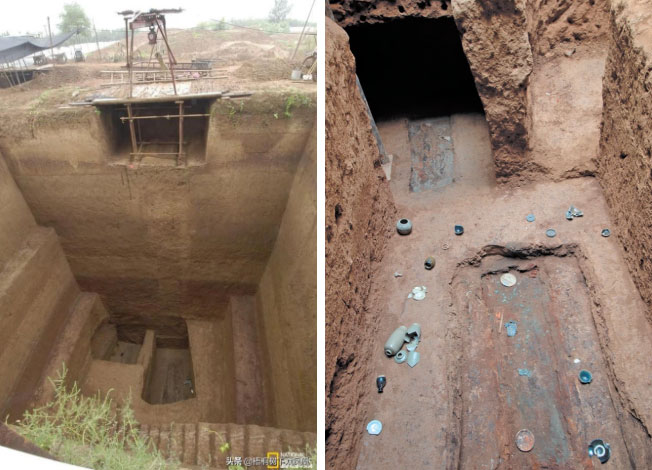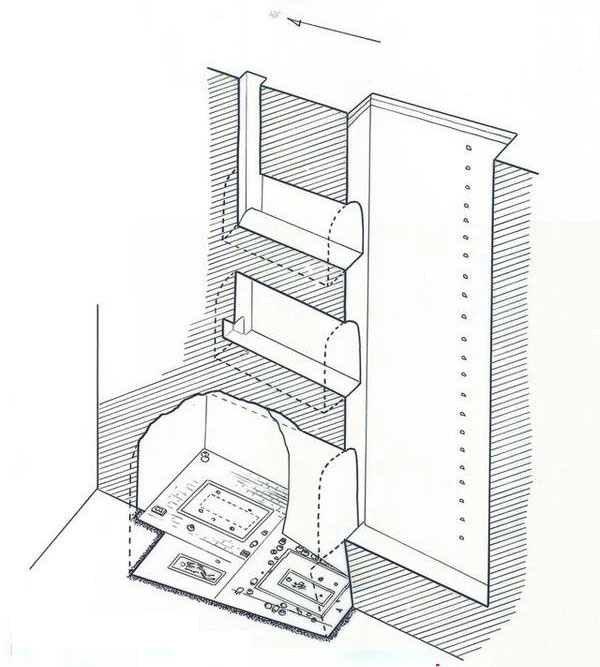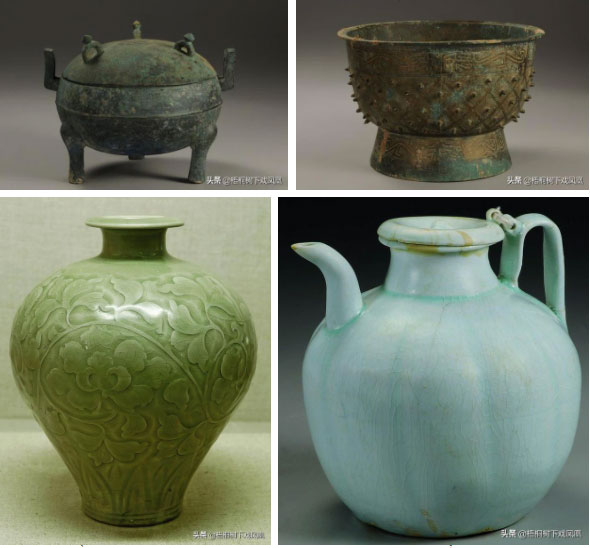This tomb system employs a unique anti-theft design known as “coffin within a coffin.” Accordingly, the tombs are buried very deep beneath a layer of hard rock, with the deepest tomb reaching 15.5 meters.
“Coffin within a coffin” – a unique anti-theft design
In November 2006, police in Xi’an, Shaanxi Province, China, intercepted a smuggling operation involving 129 cultural relics, including inscriptions from a Song Dynasty tomb. According to the suspects, all 129 artifacts were taken from an ancient tomb nearby, excavated by a man who was a distant relative of the tomb’s owner and then sold.
The Shaanxi Provincial Cultural Heritage Administration, accustomed to tomb raiding cases, quickly arrived at the scene upon discovering the unexpected tomb on the construction site, preparing for a rescue excavation.

Each tomb in the Lǔ family cemetery is between 7.5 and 15.5 meters deep. (Photo: National Geographic).
This is actually a cemetery covering nearly 90,000 m2 located in Lintian County, Shaanxi Province. The tomb complex is designated for five generations of the Lǔ family during the Song Dynasty, with the tombs arranged along an axis.
Along a central axis running from south to north, the tombs of the eldest son and grandson are arranged vertically, while the others are positioned horizontally based on their rank.
This tomb system employs a unique anti-theft design known as “coffin within a coffin.”
Accordingly, the tombs are buried very deep beneath a layer of hard rock, with the deepest tomb at 15.5 meters and the shallowest at 7.5 meters. The tombs are complexly constructed with multiple front and rear chambers, as well as parallel chambers… the upper chambers are usually empty, with only the lowest chamber containing the coffin and important burial goods.

Architectural layout of the M2 tomb area in the Lǔ family cemetery. (Photo: Chinese Archaeology).
This design forces thieves to dig through various layers of tombs without knowing which one contains the actual burial chamber.
Ancient tomb raiders, equipped only with crude shovels, found it difficult to reach the main burial chamber. Even if they managed to dig down, they risked being buried alive due to landslides or suffocating from lack of oxygen—often, the toxic gas reported in tombs is simply a result of oxygen depletion from prolonged entrapment underground.
During the excavation, even the archaeologists themselves nearly fell victim to this clever anti-theft trap.
The Forefather of Chinese Archaeology
While excavating this grand cemetery, experts uncovered clues to a significant question: Who is this prestigious lineage?
The Lǔ family is linked to Lǔ Dàilín (1044-1092), a prominent figure from the Song Dynasty considered the forefather of Chinese archaeology. Lǔ Dàilín was the first Chinese scholar to study bronze artifacts and ancient inscriptions, authoring the works “Archaeology of Artifacts” and “Translation of Archaeological Texts”, which laid the groundwork for archaeology and paleontology in China.
In these books, the scholar Lǔ meticulously sketched, cataloged, and recorded introductory notes (time, place of discovery, dimensions) for artifacts in a highly scientific manner.
Records from Lǔ Dàilín’s “Archaeology of Artifacts.” (Photo: Toutiao)
Lǔ Dàilín dedicated much of his life to studying Confucianism, and in his later years began collecting bronze artifacts, yet surprisingly, no bronze items were found in his tomb.
“There are 70 artifacts buried with Lǔ Dàilín, mostly porcelain; we suspect that the bronze items were stolen by tomb robbers. However, the remaining burial goods are exquisite, reflecting the aesthetic taste and refined lifestyle of the scholar,” said archaeologist Zhang Yun.

Exquisite burial goods found within the tomb at the Lǔ family cemetery. (Photo: Toutiao)
Although this tomb has been repeatedly raided by modern thieves—most of whom are descendants of the family—archaeologists have still managed to discover over 600 exquisite artifacts. The burial goods include ceramics, porcelain, bronze, gold, silver, and lacquerware, primarily serving daily life. They reflect, to some extent, the living conditions of a noble family during the Song Dynasty.
A significant number of tea utensils were also excavated, indicating that tea was a popular beverage among the nobility during this time.
In the tomb of Xiǎn Róng—Lǔ Dàilín’s granddaughter—a silver box containing a red powder was unearthed. Experimental results indicated that this was a type of women’s blush powder, which, after 1,000 years, remained chemically unchanged.
- Excavation of the Jin Yi Wei tomb reveals a plum wine bottle that thieves overlooked, worth up to 100 million yuan
- Is the treasure of the Egyptian Pharaoh still lying within the 4,500-year-old Great Pyramid?
- Excavating a tomb, archaeologists were horrified to see a mummy that once awakened in its coffin



















































